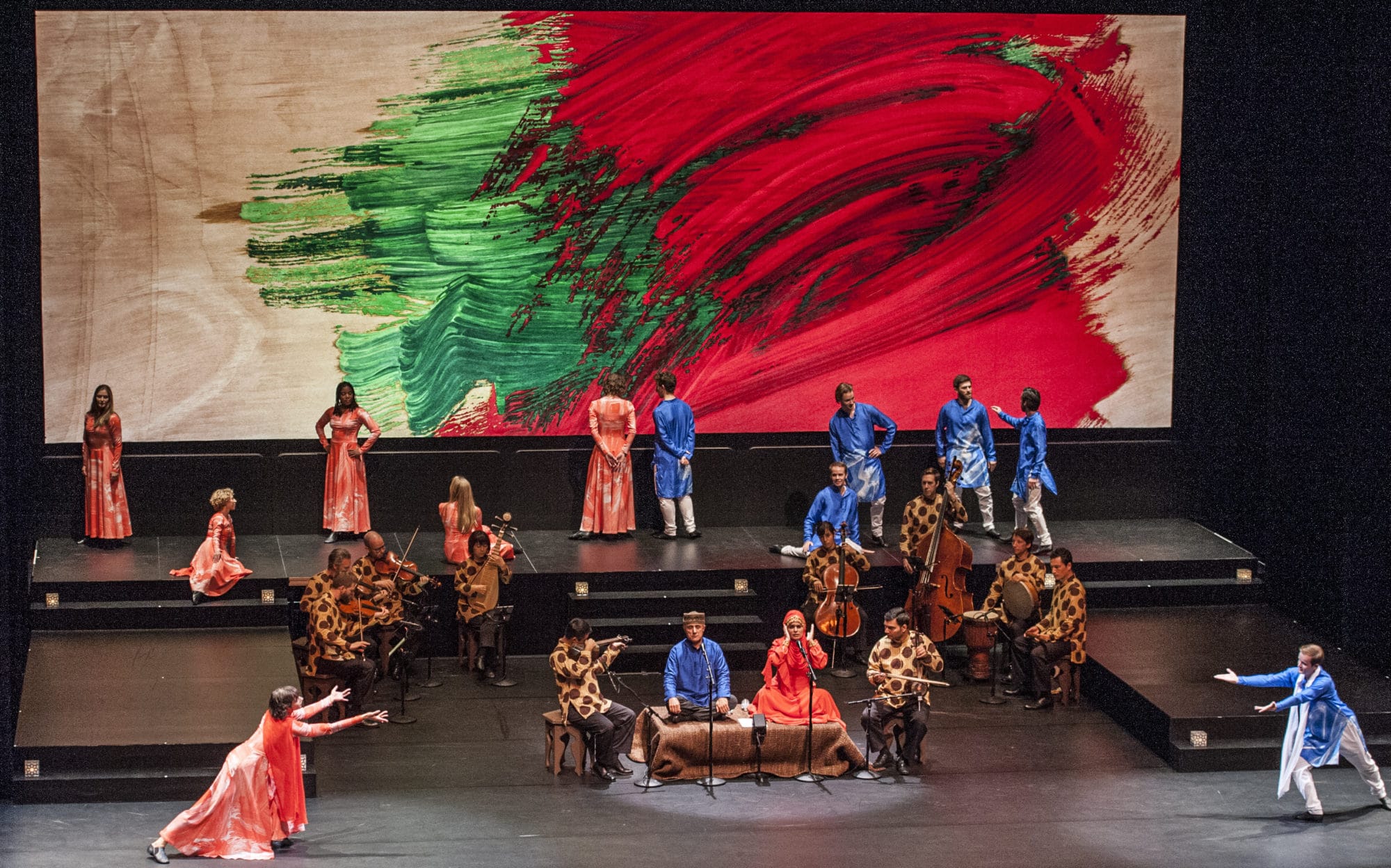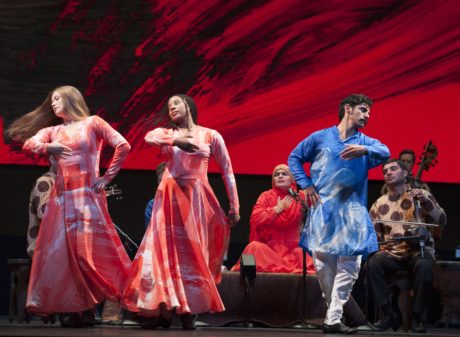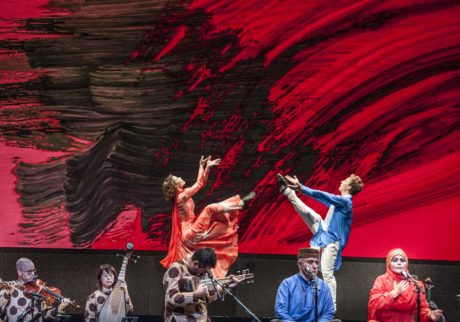A tapestry of poetry, chant, music, and dance drawn from a swath of the ancient Silk Road has provided vivid inspiration for influential choreographer Mark Morris. His re-envisioning of Layla and Majnun, the ancient tale of star-crossed lovers with roots in Persia, Azerbaijan, and other Silk Road locales (an ancient trade root which stretches across Asia from Japan to the Mediterranean Sea) fills a riveting 65 minutes. Morris’ acclaimed and beloved dance troupe has made a return Kennedy Center visit, and on opening night the full Opera House indicated that his choreographic vision continues to astound and break down cultural barriers. Modern dance and ancient Azerbaijani music? Yes, please. It works on multiple levels.

This cross-cultural collaboration, which premiered in 2016 at Berkeley’s Zellerbach Hall, knitted together celebrity cellist Yo-Yo Ma’s brainchild, the Silkroad Project, with renowned Azerbaijani father and daughter mugham singers Alim Qasimov and Fargana Qasimova, and Morris’s articulate dancers retelling a poetic tale of forbidden love. It’s no wonder the marketing material touted the work’s similarity to Romeo and Juliet, though the original tale dates back to the 12th century, about four centuries before Shakespeare penned his own star-crossed-lover tale of woe and tragedy.
Interestingly, the eight Silkroad musicians – beautifully clad in bold sunflower yellow batik prints — and the Qasimovs are placed right in the center of the stage on elevated platforms. In the five short acts, the dancers maneuver around them, up and down the stepped risers performing on various levels behind the musicians or close to the lip of the stage in front of them. It’s a subtle nod to the importance Morris gives to the music, and it’s also an acknowledgment that this East-West meeting of music and dance culture is not appropriating, it is emphasizing the ancient traditional singing and instrumentation.

With the late Howard Hodgkin’s gorgeous costumes evoking Central Asia, inspired by miniature paintings from Azerbaijan, and a striking backdrop featuring oversized brush strokes in deep green and strong orange, the work is more than dance, music or opera. I would reach back to Richard Wagner and call it gesamtkunstwerk, which means a “total work of art” or a work that synthesizes allied arts – music, dance, theater, painting, poetry – into a singular piece. In dance, during the Ballets Russes era, dancer-turned-choreographer Michel Fokine also promoted this concept. Morris gently brings it into the 21st century.
For movement material, Morris delves deep into his early dance background as a folk dancer during his teen years – think Greek, Balkan, Serbian, Macedonian – and imbues the choreography with a crystalline simplicity that relies on concise arm gestures that stretch, reach, and curve with a fine sense of plastique. His footwork, too, is spare, based on natural locomotor movements: walking, stepping, lunging, and, during a celebratory scene, hops, two-footed jumps, and tiny mincing steps that could be balletic bourres.
He uses the ballet arabesque shape as a decorative gesture akin to the curvilinear lines seen in Arabic calligraphy and art. Instead of a static geometric pose or pause, Morris’s arabesques flow with ease from a balance on one leg, the other lifted behind, into a deep lunge forward in continuous motion, like a calligrapher’s pen tracing elegant script.
The story unfurls in five brief acts, and in each a different pair of dancers play the doomed lovers, a doubling technique that Morris has used in previous works, most notably his 1989 Dido and Aeneas, where he split the central character into two roles – Dido and the destroyer – which he himself played at once. While the dancers are clad uniformly, the women in long tangerine-colored dresses, the men in sea blue silk tunics and white pants, they represent the universality and unity of the community.
Out of the many, Leyla and Majnun are each distinguished by a scarf that gets passed on from act to act. As the acts proceed, from the first “Love and Separation,” to “The Parents’ Disapproval,” to “Sorrow and despair,” to “Layla’s Unwanted Wedding,” to the final “The Lovers’ Demise,” the interchangeable couples seamlessly transform from the corps to the lead soloists. This sharing of the lead lovers lends an added sense of universality to the heartbreaking tale drawn from a Persian poem by Nezami Ganjawl, which, too, takes inspiration from older sources on the trade routes. Forbidden love, it seems, has a long and fraught history that continues to capture our hearts and catch in our throats.
The ancient narrative unspools to the plaintive chants of Qasimov and Qasimova and as their voices trill and cant, cry and tremble, you can hear the unrequited desire, the everlasting longing, the pain of separation, and the inevitable choice to choose a poignantly beautiful death over a miserable loveless life. Structurally, Morris follows the musical and poetic scores in the work and remains respectful of the Muslim culture from which it derives. The dancers’ costumes are modest, though the women’s hair does flow freely – in the spirit of young love perhaps? – and there are gendered spaces, though Morris’s democratic ethos means that even when men and women are often separated by the center-stage musicians and the risers, they perform the same gestures and steps in unison and canon.

Morris consciously nods to dance genres linked to the Silk Road – a paddle turn, one palm up and one down, recalls whirling dervishes, and he lets the dancers recline on the floor, like ancient Greeks leaning on an elbow at a banquet. The livelier dances resemble pairs of folk dancers with quick little runs, shoulders ticking forward and back, or arms slung across shoulders as short lines of men travel in grapevines like so many central European dances.
I also noted a reverence for early 20th dance modernists – Isadora Duncan and Ruth St. Denis in particular – who both sought inspiration from the art and culture of the Silk Road. In Morris, you see it in snaking arms, wide body tilts to the side, and crooked elbows and knees emphasizing angularity rather than smoothly pleasing body positions – think a sensual S-curve drawn from Indian dance, or a fleet-footed sculpture of Mercury, his lifted leg cocked behind him, ready for flight.
Most instructive of the Muslim roots of the story, Morris ensures that Layla and Majnun don’t touch until the end. And the momentary lingering of a hand on a cheek proves more effective and pure than a Hollywoodesque full-on embrace and smooch. There’s a lovely section where he surrounds his partner with an open armed hug, but their bodies never meet, and then she returns the gesture as the motif continues again and again. These moments of gendered spaces meeting with the utmost restraint reveal the power in our oversexualized society in holding back.
That, too, is the beauty of Morris’ choreographic vision in Layla and Majnun – that earthly love, while enticing, can only attain divinity when body, soul, and spirit are sacrificed for eternal love. It’s a story that continues to live across cultures and centuries – conquering intolerance with love.
Running Time: 65 minutes, with no intermission.
Layla and Majnun plays through Saturday, March 24, 2018, at the Kennedy Center – 2700 F Street, NW, in Washington, DC. For tickets, call (202) 467-4600, or purchase them online.




